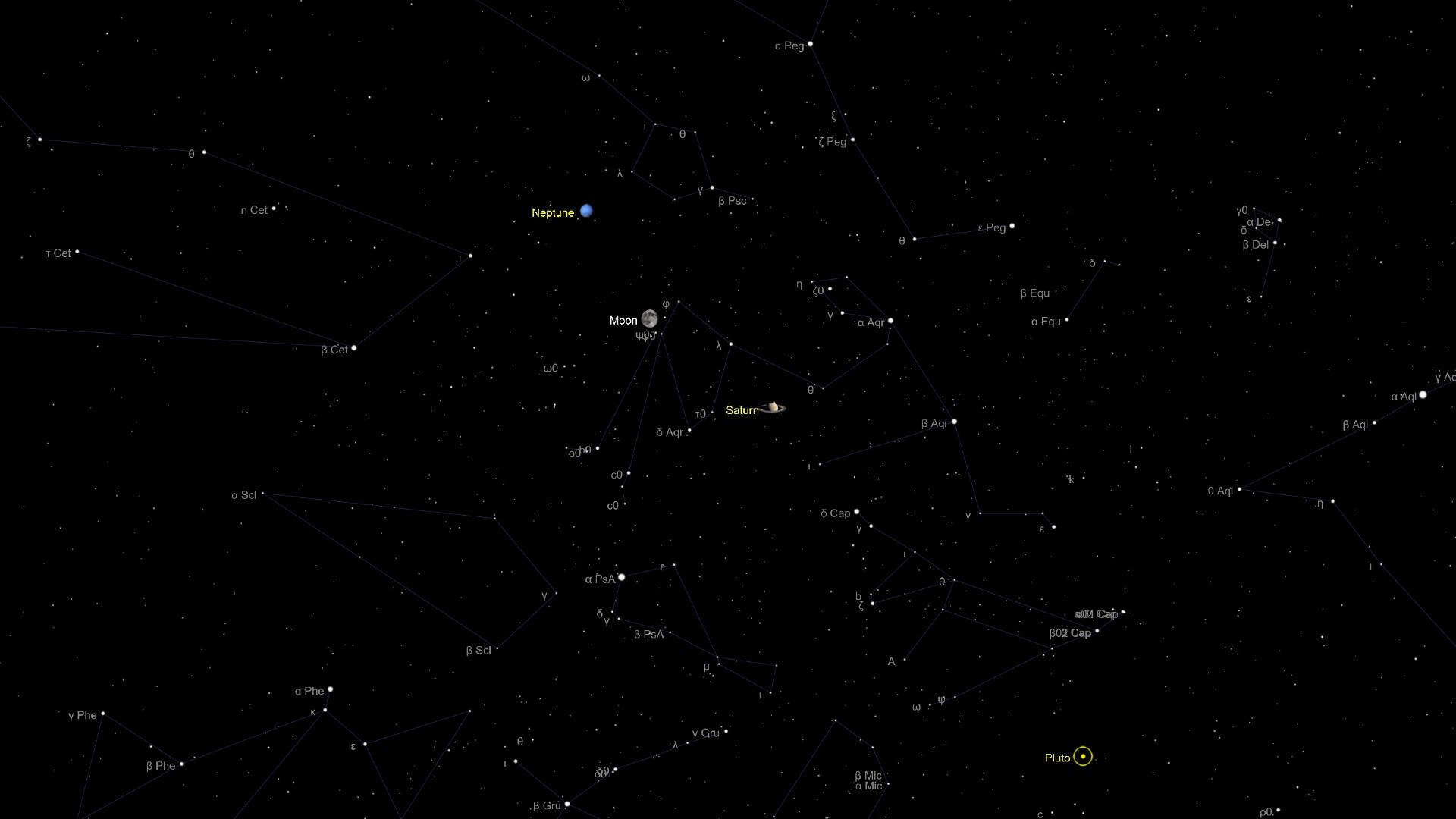See the moon snuggle up to Saturn in the night sky this week
The close approach makes for a great opportunity to locate and observe the ringed gas giant in the night sky.

The moon is set to meet up with Saturn in the night sky the next two nights.
On Wednesday (Aug. 2), the ringed planet will be just above and to the left of the moon in the night sky when both rise above the eastern horizon at around 9:45 p.m. ET (0145 GMT on Aug. 3) as seen from New York City. The duo will reach their highest point around 4:45 a.m. the next morning.
And during the conjunction on Thursday (Aug. 3), the 17-day-old waning moon will pass just 2 degrees below Saturn. A conjunction means the moon and Saturn will share the same right ascension in the sky over Earth, the celestial equivalent of longitude. During this event, the moon and the gas giant, the solar system's second largest planet, will be located in the constellation Aquarius and will be visible from New York City shortly after they rise around 9:16 p.m. EDT (0116 GMT on Aug. 4), according to In the Sky. The moon and Saturn will remain visible into the morning of Friday (Aug. 4), when they set at around 8:04 a.m. EDT (1204 GMT).
Related: Night sky, Aug. 2023: What you can see tonight [maps]

Looking for a telescope for the next night sky event? We recommend the Celestron Astro Fi 102 as the top pick in our best beginner's telescope guide.
Despite being a close approach, the two will still be two widely separated to be seen together by telescope. They should be visible together in the wider field of view of binoculars, however.
The moon will have a magnitude in the sky of -12.7, with the minus prefix reserved for particularly bright objects over Earth, and Saturn will have a magnitude of 0.5, much fainter to the unaided eye. In terms of the perceived sizes from our vantage point on the ground, the moon will absolutely dwarf Saturn in the sky over Earth on Thursday.
This situation couldn't be more different in the actual solar system. While the moon has a diameter of just 2,159 miles (3,475 kilometers), Saturn is 72,400 miles (116,500 km) wide. To put this into perspective, Saturn, the sixth planet from the sun, is 9 times the width of Earth. According to NASA, that means if Earth was a nickel, then Saturn would be a basketball. But Earth is, in turn, approximately four times the width of the moon. That means it would take at least 36 moons to loop around the equator of Saturn.
Breaking space news, the latest updates on rocket launches, skywatching events and more!
The disparity in size between the moon and Saturn becomes even clearer when considering the volume of both bodies, again using Earth as a measuring stick. It would take 764 Earths to fill the volume of Saturn, while it would take about 50 moons to fill the Earth. That means it would take roughly a staggering 38,200 moons to fill the volume of Saturn.
The reason the moon appears so much larger than Saturn in the night sky is, predictably, its proximity to our planet. While the moon is on average 238,855 miles (384,400 km) away from Earth, Saturn is still 746 million miles (1.2 billion km) from our planet at its closest point. That means the Earth/moon system could fit between Earth and Saturn over 3,123 times, even when the planet is at its closest.
As this demonstrates, when astronomers describe events like the encounter between the moon and Saturn on Thursday as a "close approach," it only refers to our limited perspective from Earth. The two are anything but "close" on the scale of the solar system, but don't let that stop you from enjoying the sight of them close in the sky!
If you are hoping to catch a look at the moon and Saturn during this close approach, our guides to the best telescopes and best binoculars are a great place to start.
If you're looking to snap photos of the moon and Saturn, or just the night sky in general, check out our guide on how to photograph the moon and how to photograph the planets, as well as our best cameras for astrophotography and best lenses for astrophotography.
Editor's Note: If you snap an image of the moon close to Saturn and would like to share it with Space.com's readers, send your photo(s), comments, and your name and location to spacephotos@space.com.

Robert Lea is a science journalist in the U.K. whose articles have been published in Physics World, New Scientist, Astronomy Magazine, All About Space, Newsweek and ZME Science. He also writes about science communication for Elsevier and the European Journal of Physics. Rob holds a bachelor of science degree in physics and astronomy from the U.K.’s Open University. Follow him on Twitter @sciencef1rst.


